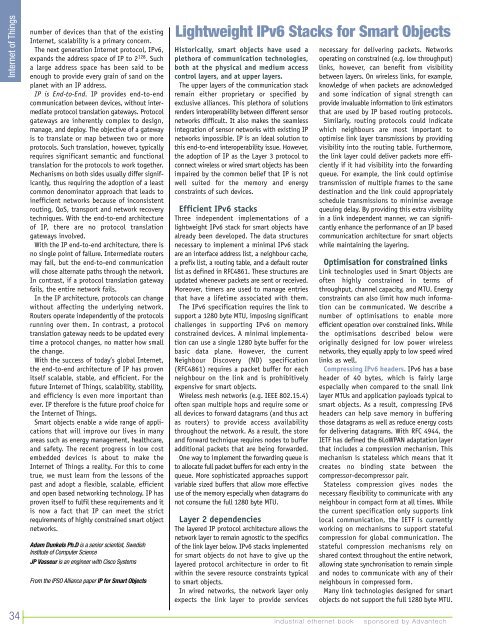industrial wireless book special edition - Networking ...
industrial wireless book special edition - Networking ...
industrial wireless book special edition - Networking ...
Create successful ePaper yourself
Turn your PDF publications into a flip-book with our unique Google optimized e-Paper software.
Internet of Things<br />
number of devices than that of the existing<br />
Internet, scalability is a primary concern.<br />
The next generation Internet protocol, IPv6,<br />
expands the address space of IP to 2 128 . Such<br />
a large address space has been said to be<br />
enough to provide every grain of sand on the<br />
planet with an IP address.<br />
IP is End-to-End. IP provides end-to-end<br />
communication between devices, without intermediate<br />
protocol translation gateways. Protocol<br />
gateways are inherently complex to design,<br />
manage, and deploy. The objective of a gateway<br />
is to translate or map between two or more<br />
protocols. Such translation, however, typically<br />
requires significant semantic and functional<br />
translation for the protocols to work together.<br />
Mechanisms on both sides usually differ significantly,<br />
thus requiring the adoption of a least<br />
common denominator approach that leads to<br />
inefficient networks because of inconsistent<br />
routing, QoS, transport and network recovery<br />
techniques. With the end-to-end architecture<br />
of IP, there are no protocol translation<br />
gateways involved.<br />
With the IP end-to-end architecture, there is<br />
no single point of failure. Intermediate routers<br />
may fail, but the end-to-end communication<br />
will chose alternate paths through the network.<br />
In contrast, if a protocol translation gateway<br />
fails, the entire network fails.<br />
In the IP architecture, protocols can change<br />
without affecting the underlying network.<br />
Routers operate independently of the protocols<br />
running over them. In contrast, a protocol<br />
translation gateway needs to be updated every<br />
time a protocol changes, no matter how small<br />
the change.<br />
With the success of today’s global Internet,<br />
the end-to-end architecture of IP has proven<br />
itself scalable, stable, and efficient. For the<br />
future Internet of Things, scalability, stability,<br />
and efficiency is even more important than<br />
ever. IP therefore is the future proof choice for<br />
the Internet of Things.<br />
Smart objects enable a wide range of applications<br />
that will improve our lives in many<br />
areas such as energy management, healthcare,<br />
and safety. The recent progress in low cost<br />
embedded devices is about to make the<br />
Internet of Things a reality. For this to come<br />
true, we must learn from the lessons of the<br />
past and adopt a flexible, scalable, efficient<br />
and open based networking technology. IP has<br />
proven itself to fulfil these requirements and it<br />
is now a fact that IP can meet the strict<br />
requirements of highly constrained smart object<br />
networks.<br />
Adam Dunkels Ph.D is a senior scientist, Swedish<br />
Institute of Computer Science<br />
JP Vasseur is an engineer with Cisco Systems<br />
From the IPSO Alliance paper IP for Smart Objects<br />
Lightweight IPv6 Stacks for Smart Objects<br />
Historically, smart objects have used a<br />
plethora of communication technologies,<br />
both at the physical and medium access<br />
control layers, and at upper layers.<br />
The upper layers of the communication stack<br />
remain either proprietary or specified by<br />
exclusive alliances. This plethora of solutions<br />
renders interoperability between different sensor<br />
networks difficult. It also makes the seamless<br />
integration of sensor networks with existing IP<br />
networks impossible. IP is an ideal solution to<br />
this end-to-end interoperability issue. However,<br />
the adoption of IP as the Layer 3 protocol to<br />
connect <strong>wireless</strong> or wired smart objects has been<br />
impaired by the common belief that IP is not<br />
well suited for the memory and energy<br />
constraints of such devices.<br />
Efficient IPv6 stacks<br />
Three independent implementations of a<br />
lightweight IPv6 stack for smart objects have<br />
already been developed. The data structures<br />
necessary to implement a minimal IPv6 stack<br />
are an interface address list, a neighbour cache,<br />
a prefix list, a routing table, and a default router<br />
list as defined in RFC4861. These structures are<br />
updated whenever packets are sent or received.<br />
Moreover, timers are used to manage entries<br />
that have a lifetime associated with them.<br />
The IPv6 specification requires the link to<br />
support a 1280 byte MTU, imposing significant<br />
challenges in supporting IPv6 on memory<br />
constrained devices. A minimal implementation<br />
can use a single 1280 byte buffer for the<br />
basic data plane. However, the current<br />
Neighbour Discovery (ND) specification<br />
(RFC4861) requires a packet buffer for each<br />
neighbour on the link and is prohibitively<br />
expensive for smart objects.<br />
Wireless mesh networks (e.g. IEEE 802.15.4)<br />
often span multiple hops and require some or<br />
all devices to forward datagrams (and thus act<br />
as routers) to provide access availability<br />
throughout the network. As a result, the store<br />
and forward technique requires nodes to buffer<br />
additional packets that are being forwarded.<br />
One way to implement the forwarding queue is<br />
to allocate full packet buffers for each entry in the<br />
queue. More sophisticated approaches support<br />
variable sized buffers that allow more effective<br />
use of the memory e<strong>special</strong>ly when datagrams do<br />
not consume the full 1280 byte MTU.<br />
Layer 2 dependencies<br />
The layered IP protocol architecture allows the<br />
network layer to remain agnostic to the specifics<br />
of the link layer below. IPv6 stacks implemented<br />
for smart objects do not have to give up the<br />
layered protocol architecture in order to fit<br />
within the severe resource constraints typical<br />
to smart objects.<br />
In wired networks, the network layer only<br />
expects the link layer to provide services<br />
necessary for delivering packets. Networks<br />
operating on constrained (e.g. low throughput)<br />
links, however, can benefit from visibility<br />
between layers. On <strong>wireless</strong> links, for example,<br />
knowledge of when packets are acknowledged<br />
and some indication of signal strength can<br />
provide invaluable information to link estimators<br />
that are used by IP based routing protocols.<br />
Similarly, routing protocols could indicate<br />
which neighbours are most important to<br />
optimise link layer transmissions by providing<br />
visibility into the routing table. Furthermore,<br />
the link layer could deliver packets more efficiently<br />
if it had visibility into the forwarding<br />
queue. For example, the link could optimise<br />
transmission of multiple frames to the same<br />
destination and the link could appropriately<br />
schedule transmissions to minimise average<br />
queuing delay. By providing this extra visibility<br />
in a link independent manner, we can significantly<br />
enhance the performance of an IP based<br />
communication architecture for smart objects<br />
while maintaining the layering.<br />
Optimisation for constrained links<br />
Link technologies used in Smart Objects are<br />
often highly constrained in terms of<br />
throughput, channel capacity, and MTU. Energy<br />
constraints can also limit how much information<br />
can be communicated. We describe a<br />
number of optimisations to enable more<br />
efficient operation over constrained links. While<br />
the optimisations described below were<br />
originally designed for low power <strong>wireless</strong><br />
networks, they equally apply to low speed wired<br />
links as well.<br />
Compressing IPv6 headers. IPv6 has a base<br />
header of 40 bytes, which is fairly large<br />
e<strong>special</strong>ly when compared to the small link<br />
layer MTUs and application payloads typical to<br />
smart objects. As a result, compressing IPv6<br />
headers can help save memory in buffering<br />
those datagrams as well as reduce energy costs<br />
for delivering datagrams. With RFC 4944, the<br />
IETF has defined the 6LoWPAN adaptation layer<br />
that includes a compression mechanism. This<br />
mechanism is stateless which means that it<br />
creates no binding state between the<br />
compressor-decompressor pair.<br />
Stateless compression gives nodes the<br />
necessary flexibility to communicate with any<br />
neighbour in compact form at all times. While<br />
the current specification only supports link<br />
local communication, the IETF is currently<br />
working on mechanisms to support stateful<br />
compression for global communication. The<br />
stateful compression mechanisms rely on<br />
shared context throughout the entire network,<br />
allowing state synchronisation to remain simple<br />
and nodes to communicate with any of their<br />
neighbours in compressed form.<br />
Many link technologies designed for smart<br />
objects do not support the full 1280 byte MTU.<br />
34<br />
<strong>industrial</strong> ethernet <strong>book</strong><br />
sponsored by Advantech

















